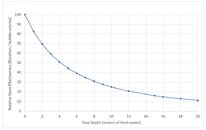Agreed! This is the biggest issue with DeComp Science, that the varriables are, er, too varriable!
What set me off on this line of questioning was if there was an empirical evidence (rather than theoretical or model based) for the appearance of DCS below say 10m.
This i found interesting because the gas compression is an inverse exponential against depth, but gas consumption is broadly linear with depth.
For example:
at 5m, where ambient pressure is 1.5 bar(abs), gas volume is 66% of Surface Volume, and OC consumption is 150% of Surface Consumption
at 10m, where ambient pressure is 2 bar (abs) so gas volume is 50% of SV, and OC consumption is 200% of SC
at 20m, where ambient pressure is 3 bar (abs) so gas volume is 33% of SV, and OC consumption is 300% of SC
Assuming no surface hung/dropped air supply is available, then obviously the maximum amount of deco time on any given remaining gas is going to be longer the shallower you are.
At our 5m point above we are using 50% more air than on the boat, but our bubbles are (nominally) 44% smaller
At our 10m point, we are using 100% more air, and our bubbles are 50% smaller
At our 20m point, we are using 200% more air, and our bubbles are 66% smaller
So in a theoretical emergency situation, what is the best depth to stop at and use up ALL your remaining gas? The answer is as shallow as possible whilst juuust avoiding any symptoms of DCS !! Hence my initial question






